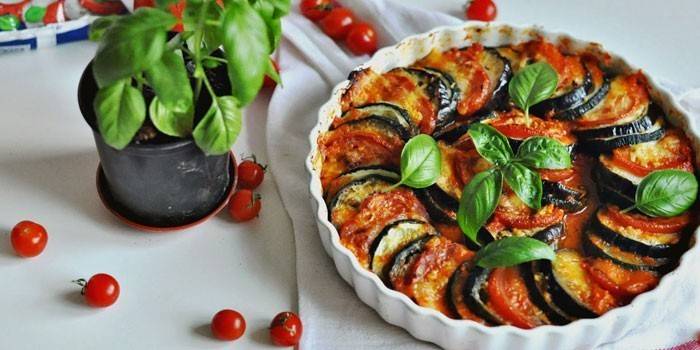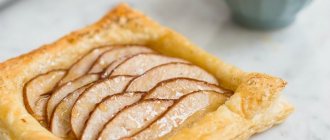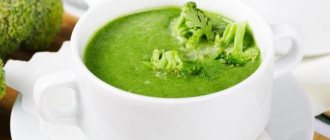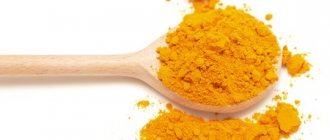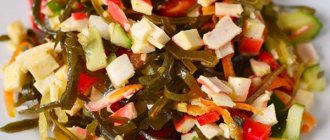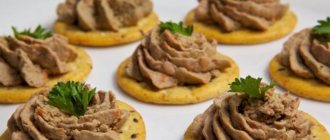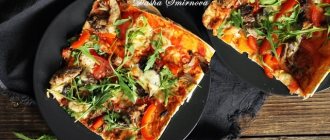Ratatouille recipe. Calorie, chemical composition and nutritional value.
Nutritional value and chemical composition of Ratatouille.
The table shows the nutritional content (calories, proteins, fats, carbohydrates, vitamins and minerals) per 100 grams of edible portion.
| Nutrient | Quantity | Norm** | % of the norm in 100 g | % of the norm in 100 kcal | 100% normal |
| Calorie content | 44.6 kcal | 1684 kcal | 2.6% | 5.8% | 3776 g |
| Squirrels | 1.2 g | 76 g | 1.6% | 3.6% | 6333 g |
| Fats | 1.7 g | 56 g | 3% | 6.7% | 3294 g |
| Carbohydrates | 6.3 g | 219 g | 2.9% | 6.5% | 3476 g |
| Organic acids | 0.2 g | ~ | |||
| Alimentary fiber | 1.8 g | 20 g | 9% | 20.2% | 1111 g |
| Water | 88.1 g | 2273 g | 3.9% | 8.7% | 2580 g |
| Ash | 0.748 g | ~ | |||
| Vitamins | |||||
| Vitamin A, RE | 48.6 mcg | 900 mcg | 5.4% | 12.1% | 1852 |
| alpha carotene | 2.85 mcg | ~ | |||
| beta carotene | 0.331 mg | 5 mg | 6.6% | 14.8% | 1511 g |
| beta Cryptoxanthin | 6.057 mcg | ~ | |||
| Lutein + Zeaxanthin | 89.433 mcg | ~ | |||
| Vitamin B1, thiamine | 0.058 mg | 1.5 mg | 3.9% | 8.7% | 2586 g |
| Vitamin B2, riboflavin | 0.05 mg | 1.8 mg | 2.8% | 6.3% | 3600 g |
| Vitamin B4, choline | 4.3 mg | 500 mg | 0.9% | 2% | 11628 g |
| Vitamin B5, pantothenic | 0.184 mg | 5 mg | 3.7% | 8.3% | 2717 g |
| Vitamin B6, pyridoxine | 0.232 mg | 2 mg | 11.6% | 26% | 862 g |
| Vitamin B9, folates | 25.601 mcg | 400 mcg | 6.4% | 14.3% | 1562 g |
| Vitamin C, ascorbic acid | 32.83 mg | 90 mg | 36.5% | 81.8% | 274 g |
| Vitamin E, alpha tocopherol, TE | 0.338 mg | 15 mg | 2.3% | 5.2% | 4438 g |
| Vitamin H, biotin | 0.704 mcg | 50 mcg | 1.4% | 3.1% | 7102 g |
| Vitamin K, phylloquinone | 14.2 mcg | 120 mcg | 11.8% | 26.5% | 845 g |
| Vitamin RR, NE | 0.9868 mg | 20 mg | 4.9% | 11% | 2027 |
| Niacin | 0.61 mg | ~ | |||
| Macronutrients | |||||
| Potassium, K | 307.26 mg | 2500 mg | 12.3% | 27.6% | 814 g |
| Calcium, Ca | 20.73 mg | 1000 mg | 2.1% | 4.7% | 4824 g |
| Magnesium, Mg | 18.68 mg | 400 mg | 4.7% | 10.5% | 2141 g |
| Sodium, Na | 9.42 mg | 1300 mg | 0.7% | 1.6% | 13800 g |
| Sera, S | 16.32 mg | 1000 mg | 1.6% | 3.6% | 6127 g |
| Phosphorus, Ph | 40.9 mg | 800 mg | 5.1% | 11.4% | 1956 |
| Chlorine, Cl | 40.3 mg | 2300 mg | 1.8% | 4% | 5707 g |
| Microelements | |||||
| Aluminium, Al | 295.1 mcg | ~ | |||
| Bor, B | 98.2 mcg | ~ | |||
| Iron, Fe | 0.639 mg | 18 mg | 3.6% | 8.1% | 2817 g |
| Yod, I | 1.81 mcg | 150 mcg | 1.2% | 2.7% | 8287 g |
| Cobalt, Co | 3.31 mcg | 10 mcg | 33.1% | 74.2% | 302 g |
| Manganese, Mn | 0.1889 mg | 2 mg | 9.4% | 21.1% | 1059 g |
| Copper, Cu | 119.34 mcg | 1000 mcg | 11.9% | 26.7% | 838 g |
| Molybdenum, Mo | 5.91 mcg | 70 mcg | 8.4% | 18.8% | 1184 g |
| Nickel, Ni | 5.527 mcg | ~ | |||
| Rubidium, Rb | 111.5 mcg | ~ | |||
| Selenium, Se | 0.321 mcg | 55 mcg | 0.6% | 1.3% | 17134 g |
| Fluorine, F | 15.63 mcg | 4000 mcg | 0.4% | 0.9% | 25592 g |
| Chromium, Cr | 2.22 mcg | 50 mcg | 4.4% | 9.9% | 2252 g |
| Zinc, Zn | 0.327 mg | 12 mg | 2.7% | 6.1% | 3670 g |
| Digestible carbohydrates | |||||
| Starch and dextrins | 0.612 g | ~ | |||
| Mono- and disaccharides (sugars) | 5.3 g | max 100 g | |||
| Glucose (dextrose) | 1.068 g | ~ | |||
| Sucrose | 0.81 g | ~ | |||
| Fructose | 0.375 g | ~ | |||
| Essential amino acids | 0.143 g | ~ | |||
| Arginine* | 0.043 g | ~ | |||
| Valin | 0.031 g | ~ | |||
| Histidine* | 0.013 g | ~ | |||
| Isoleucine | 0.028 g | ~ | |||
| Leucine | 0.028 g | ~ | |||
| Lysine | 0.03 g | ~ | |||
| Methionine | 0.006 g | ~ | |||
| Methionine + Cysteine | 0.008 g | ~ | |||
| Threonine | 0.024 g | ~ | |||
| Tryptophan | 0.008 g | ~ | |||
| Phenylalanine | 0.026 g | ~ | |||
| Phenylalanine+Tyrosine | 0.042 g | ~ | |||
| Nonessential amino acids | 0.303 g | ~ | |||
| Alanin | 0.034 g | ~ | |||
| Aspartic acid | 0.082 g | ~ | |||
| Glycine | 0.026 g | ~ | |||
| Glutamic acid | 0.103 g | ~ | |||
| Proline | 0.028 g | ~ | |||
| Serin | 0.025 g | ~ | |||
| Tyrosine | 0.023 g | ~ | |||
| Cysteine | 0.006 g | ~ | |||
| Saturated fatty acids | |||||
| 16:0 Palmitinaya | 0.006 g | ~ | |||
| 18:0 Stearic | 0.001 g | ~ | |||
| Monounsaturated fatty acids | 0.004 g | min 16.8 g | |||
| 18:1 Oleic (omega-9) | 0.004 g | ~ | |||
| Polyunsaturated fatty acids | 0.043 g | from 11.2 to 20.6 g | 0.4% | 0.9% | |
| 18:2 Linolevaya | 0.041 g | ~ | |||
| 18:3 Linolenic | 0.002 g | ~ |
The energy value of Ratatouille is 44.6 kcal.
Primary Source: Created in the application by the user. Read more.
** This table shows the average levels of vitamins and minerals for an adult. If you want to know the norms taking into account your gender, age and other factors, then use the “My Healthy Diet” application.
health-diet.ru
Ratatouille recipe. Calorie, chemical composition and nutritional value.
Nutritional value and chemical composition of ratatouille.
The table shows the nutritional content (calories, proteins, fats, carbohydrates, vitamins and minerals) per 100 grams of edible portion.
| Nutrient | Quantity | Norm** | % of the norm in 100 g | % of the norm in 100 kcal | 100% normal |
| Calorie content | 32.8 kcal | 1684 kcal | 1.9% | 5.8% | 5134 g |
| Squirrels | 1.4 g | 76 g | 1.8% | 5.5% | 5429 g |
| Fats | 0.3 g | 56 g | 0.5% | 1.5% | 18667 |
| Carbohydrates | 6.8 g | 219 g | 3.1% | 9.5% | 3221 g |
| Organic acids | 0.2 g | ~ | |||
| Alimentary fiber | 2 g | 20 g | 10% | 30.5% | 1000 g |
| Water | 89 g | 2273 g | 3.9% | 11.9% | 2554 g |
| Vitamins | |||||
| Vitamin A, RE | 35.6 mcg | 900 mcg | 4% | 12.2% | 2528 g |
| beta carotene | 0.28 mg | 5 mg | 5.6% | 17.1% | 1786 |
| Vitamin B1, thiamine | 0.041 mg | 1.5 mg | 2.7% | 8.2% | 3659 g |
| Vitamin B2, riboflavin | 0.05 mg | 1.8 mg | 2.8% | 8.5% | 3600 g |
| Vitamin B4, choline | 7.74 mg | 500 mg | 1.5% | 4.6% | 6460 g |
| Vitamin B5, pantothenic | 0.15 mg | 5 mg | 3% | 9.1% | 3333 g |
| Vitamin B6, pyridoxine | 0.135 mg | 2 mg | 6.8% | 20.7% | 1481 g |
| Vitamin B9, folates | 12.903 mcg | 400 mcg | 3.2% | 9.8% | 3100 g |
| Vitamin C, ascorbic acid | 15.48 mg | 90 mg | 17.2% | 52.4% | 581 g |
| Vitamin E, alpha tocopherol, TE | 0.819 mg | 15 mg | 5.5% | 16.8% | 1832 |
| Vitamin H, biotin | 0.537 mcg | 50 mcg | 1.1% | 3.4% | 9311 g |
| Vitamin K, phylloquinone | 3.8 mcg | 120 mcg | 3.2% | 9.8% | 3158 g |
| Vitamin RR, NE | 1.0404 mg | 20 mg | 5.2% | 15.9% | 1922 |
| Macronutrients | |||||
| Potassium, K | 349.19 mg | 2500 mg | 14% | 42.7% | 716 g |
| Calcium, Ca | 20.71 mg | 1000 mg | 2.1% | 6.4% | 4829 g |
| Magnesium, Mg | 17.53 mg | 400 mg | 4.4% | 13.4% | 2282 g |
| Sodium, Na | 185.33 mg | 1300 mg | 14.3% | 43.6% | 701 g |
| Sera, S | 11.67 mg | 1000 mg | 1.2% | 3.7% | 8569 g |
| Phosphorus, Ph | 36.7 mg | 800 mg | 4.6% | 14% | 2180 g |
| Chlorine, Cl | 286.7 mg | 2300 mg | 12.5% | 38.1% | 802 g |
| Microelements | |||||
| Bor, B | 61.2 mcg | ~ | |||
| Iron, Fe | 0.869 mg | 18 mg | 4.8% | 14.6% | 2071 g |
| Yod, I | 1.14 mcg | 150 mcg | 0.8% | 2.4% | 13158 g |
| Cobalt, Co | 2.304 mcg | 10 mcg | 23% | 70.1% | 434 g |
| Manganese, Mn | 0.1385 mg | 2 mg | 6.9% | 21% | 1444 g |
| Copper, Cu | 111.41 mcg | 1000 mcg | 11.1% | 33.8% | 898 g |
| Molybdenum, Mo | 3.656 mcg | 70 mcg | 5.2% | 15.9% | 1915 |
| Selenium, Se | 1.025 mcg | 55 mcg | 1.9% | 5.8% | 5366 g |
| Fluorine, F | 9.87 mcg | 4000 mcg | 0.2% | 0.6% | 40527 g |
| Chromium, Cr | 1.5 mcg | 50 mcg | 3% | 9.1% | 3333 g |
| Zinc, Zn | 0.2721 mg | 12 mg | 2.3% | 7% | 4410 g |
The energy value of ratatouille is 32.8 kcal.
Primary Source: Created in the application by the user. Read more.
** This table shows the average levels of vitamins and minerals for an adult. If you want to know the norms taking into account your gender, age and other factors, then use the “My Healthy Diet” application.
health-diet.ru
Ratatouille calories. Chemical composition and nutritional value.
Nutritional value and chemical composition of ratatouille.
The table shows the nutritional content (calories, proteins, fats, carbohydrates, vitamins and minerals) per 100 grams of edible portion.
| Nutrient | Quantity | Norm** | % of the norm in 100 g | % of the norm in 100 kcal | 100% normal |
| Calorie content | 97.4 kcal | 1684 kcal | 5.8% | 6% | 1729 g |
| Squirrels | 11.8 g | 76 g | 15.5% | 15.9% | 644 g |
| Fats | 3.7 g | 56 g | 6.6% | 6.8% | 1514 g |
| Carbohydrates | 4.2 g | 219 g | 1.9% | 2% | 5214 g |
| Organic acids | 0.2 g | ~ | |||
| Alimentary fiber | 1.6 g | 20 g | 8% | 8.2% | 1250 g |
| Water | 72.7 g | 2273 g | 3.2% | 3.3% | 3127 g |
| Ash | 0.7 g | ~ | |||
| Vitamins | |||||
| Vitamin A, RE | 300 mcg | 900 mcg | 33.3% | 34.2% | 300 g |
| Retinol | 0.3 mg | ~ | |||
| Vitamin B1, thiamine | 0.04 mg | 1.5 mg | 2.7% | 2.8% | 3750 g |
| Vitamin B2, riboflavin | 0.04 mg | 1.8 mg | 2.2% | 2.3% | 4500 g |
| Vitamin B5, pantothenic | 0.06 mg | 5 mg | 1.2% | 1.2% | 8333 g |
| Vitamin B6, pyridoxine | 0.2 mg | 2 mg | 10% | 10.3% | 1000 g |
| Vitamin B9, folates | 8.2 mcg | 400 mcg | 2.1% | 2.2% | 4878 g |
| Vitamin C, ascorbic acid | 13 mg | 90 mg | 14.4% | 14.8% | 692 g |
| Vitamin E, alpha tocopherol, TE | 14 mg | 15 mg | 93.3% | 95.8% | 107 g |
| Vitamin H, biotin | 0.3 mcg | 50 mcg | 0.6% | 0.6% | 16667 g |
| Vitamin RR, NE | 0.7822 mg | 20 mg | 3.9% | 4% | 2557 g |
| Niacin | 0.5 mg | ~ | |||
| Macronutrients | |||||
| Potassium, K | 173.7 mg | 2500 mg | 6.9% | 7.1% | 1439 g |
| Calcium, Ca | 36.3 mg | 1000 mg | 3.6% | 3.7% | 2755 g |
| Magnesium, Mg | 12 mg | 400 mg | 3% | 3.1% | 3333 g |
| Sodium, Na | 12.8 mg | 1300 mg | 1% | 1% | 10156 g |
| Sera, S | 11.3 mg | 1000 mg | 1.1% | 1.1% | 8850 g |
| Phosphorus, Ph | 33.1 mg | 800 mg | 4.1% | 4.2% | 2417 g |
| Chlorine, Cl | 29.5 mg | 2300 mg | 1.3% | 1.3% | 7797 g |
| Microelements | |||||
| Aluminium, Al | 228.2 mcg | ~ | |||
| Bor, B | 62.4 mcg | ~ | |||
| Iron, Fe | 0.6 mg | 18 mg | 3.3% | 3.4% | 3000 g |
| Yod, I | 2.6 mcg | 150 mcg | 1.7% | 1.7% | 5769 g |
| Cobalt, Co | 3.3 mcg | 10 mcg | 33% | 33.9% | 303 g |
| Manganese, Mn | 0.2251 mg | 2 mg | 11.3% | 11.6% | 888 g |
| Copper, Cu | 84.2 mcg | 1000 mcg | 8.4% | 8.6% | 1188 g |
| Molybdenum, Mo | 3.7 mcg | 70 mcg | 5.3% | 5.4% | 1892 |
| Nickel, Ni | 2.7 mcg | ~ | |||
| Rubidium, Rb | 68.8 mcg | ~ | |||
| Fluorine, F | 10 mcg | 4000 mcg | 0.3% | 0.3% | 40000 g |
| Chromium, Cr | 1.4 mcg | 50 mcg | 2.8% | 2.9% | 3571 g |
| Zinc, Zn | 0.3524 mg | 12 mg | 2.9% | 3% | 3405 g |
| Digestible carbohydrates | |||||
| Starch and dextrins | 4 g | ~ | |||
| Mono- and disaccharides (sugars) | 2.7 g | max 100 g |
The energy value of ratatouille is 97.4 kcal.
Primary Source: Created in the application by the user. Read more.
** This table shows the average levels of vitamins and minerals for an adult. If you want to know the norms taking into account your gender, age and other factors, then use the “My Healthy Diet” application.
health-diet.ru
Calories in Ratatouille. Chemical composition and nutritional value.
Nutritional value and chemical composition of Ratatouille.
The table shows the nutritional content (calories, proteins, fats, carbohydrates, vitamins and minerals) per 100 grams of edible portion.
| Nutrient | Quantity | Norm** | % of the norm in 100 g | % of the norm in 100 kcal | 100% normal |
| Calorie content | 69.4 kcal | 1684 kcal | 4.1% | 5.9% | 2427 g |
| Squirrels | 0.9 g | 76 g | 1.2% | 1.7% | 8444 g |
| Fats | 5.2 g | 56 g | 9.3% | 13.4% | 1077 g |
| Carbohydrates | 4.8 g | 219 g | 2.2% | 3.2% | 4563 g |
The energy value of Ratatouille is 69.4 kcal.
Primary Source: Created in the application by the user. Read more.
** This table shows the average levels of vitamins and minerals for an adult. If you want to know the norms taking into account your gender, age and other factors, then use the “My Healthy Diet” application.
health-diet.ru
What is ratatouille made from?
Ratatouille is a dish made from vegetables with the addition of Provençal herbs. The composition includes zucchini, tomatoes, eggplants, onions, bell peppers. In essence, this is an ordinary Hungarian stew, but it is prepared in a special way. Ratatouille is famous for the fact that it contains vegetables that are combined with each other, so if you follow the recipe and maintain the proportions, the taste of ratatouille will be perfect. In addition, the result looks very beautiful in the photo.
- How to lose weight with Bonn soup
- Diet of ballerinas
- Refund of insurance after repayment of loan from Sberbank
History of the dish
The French vegetable dish ratatouille (ratatouille - French) was invented a long time ago in Nice, where peasants served such a stew with meat, fish or poultry. It was prepared from what was collected from the garden, so it was considered a very budget-friendly way to feed the whole family. Gradually, the dish began to be served in rich houses. Today ratatouille can be seen on the menu of even the most expensive restaurants, because this French dish is deservedly one of the most delicious side dishes that goes well with poultry, meat or fish.
Calories in Ratatouille. Chemical composition and nutritional value.
Nutritional value and chemical composition of Ratatouille.
The table shows the nutritional content (calories, proteins, fats, carbohydrates, vitamins and minerals) per 100 grams of edible portion.
| Nutrient | Quantity | Norm** | % of the norm in 100 g | % of the norm in 100 kcal | 100% normal |
| Calorie content | 43.6 kcal | 1684 kcal | 2.6% | 6% | 3862 g |
| Squirrels | 1.1 g | 76 g | 1.4% | 3.2% | 6909 g |
| Fats | 2.7 g | 56 g | 4.8% | 11% | 2074 g |
| Carbohydrates | 4.9 g | 219 g | 2.2% | 5% | 4469 g |
| Organic acids | 1.8 g | ~ | |||
| Alimentary fiber | 1.8 g | 20 g | 9% | 20.6% | 1111 g |
| Water | 90.8 g | 2273 g | 4% | 9.2% | 2503 g |
| Ash | 0.6 g | ~ | |||
| Vitamins | |||||
| Vitamin B2, riboflavin | 0.1 mg | 1.8 mg | 5.6% | 12.8% | 1800 g |
| Vitamin B6, pyridoxine | 0.2 mg | 2 mg | 10% | 22.9% | 1000 g |
| Vitamin C, ascorbic acid | 23.7 mg | 90 mg | 26.3% | 60.3% | 380 g |
| Vitamin E added | 0.7 mg | ~ | |||
| Vitamin K, phylloquinone | 16.4 mcg | 120 mcg | 13.7% | 31.4% | 732 g |
| Macronutrients | |||||
| Potassium, K | 234 mg | 2500 mg | 9.4% | 21.6% | 1068 g |
| Calcium, Ca | 14.4 mg | 1000 mg | 1.4% | 3.2% | 6944 g |
| Phosphorus, Ph | 30.1 mg | 800 mg | 3.8% | 8.7% | 2658 g |
| Microelements | |||||
| Iron, Fe | 0.4 mg | 18 mg | 2.2% | 5% | 4500 g |
| Manganese, Mn | 0.2 mg | 2 mg | 10% | 22.9% | 1000 g |
| Copper, Cu | 0.1 mcg | 1000 mcg | 1000000 g | ||
| Zinc, Zn | 0.2 mg | 12 mg | 1.7% | 3.9% | 6000 g |
| Digestible carbohydrates | |||||
| Mono- and disaccharides (sugars) | 2.2 g | max 100 g |
The energy value of Ratatouille is 43.6 kcal.
Primary Source: Created in the application by the user. Read more.
** This table shows the average levels of vitamins and minerals for an adult. If you want to know the norms taking into account your gender, age and other factors, then use the “My Healthy Diet” application.
health-diet.ru
Classic ratatouille
- Time: 30 minutes.
- Number of servings: 5 persons.
- Calorie content of the dish: 1200 kcal.
- Purpose: for breakfast.
- Cuisine: French.
- Difficulty: easy.
The classic version of preparing ratatouille is known to almost all housewives and cooks in Europe. In our country it is gaining popularity due to its ease of process. In addition, the products necessary for cooking can always be found in the store, and in the summer they can even be collected from the garden. It is not necessary to bake vegetables until they are very soft: monitor the condition of the vegetables and remove them from the oven when you want.
- Pickled cucumbers without sterilization
- Soy in the blood
- Vitiligo disease
Ingredients:
- tomatoes – 6 pcs.;
- zucchini – 1 pc.;
- bell pepper – 1 pc.;
- eggplant – 1 pc.;
- garlic – 2 cloves;
- onion – 1 pc.;
- olive oil – 50 ml;
- salt, pepper - to taste;
- Provencal herbs.
Cooking method:
- Vegetables are well washed and dried.
- Prepare the sauce: cut 2 tomatoes, onion, garlic into cubes. Fry in a heated frying pan with oil, then cover with a lid and simmer until you get a sauce.
- Cut the remaining vegetables into slices.
- Pour the resulting sauce into the mold.
- Place chopped vegetables on top, alternating with each other.
- Mix Provençal herbs with olive oil and pour over the vegetables.
- Place in an oven preheated to 180 degrees and bake for 1 hour.
- If you do not like very soft vegetables, then reduce the baking time as desired.
Calories in Ratatouille. Chemical composition and nutritional value.
Nutritional value and chemical composition of Ratatouille.
The table shows the nutritional content (calories, proteins, fats, carbohydrates, vitamins and minerals) per 100 grams of edible portion.
| Nutrient | Quantity | Norm** | % of the norm in 100 g | % of the norm in 100 kcal | 100% normal |
| Calorie content | 59 kcal | 1684 kcal | 3.5% | 5.9% | 2854 g |
| Squirrels | 0.9 g | 76 g | 1.2% | 2% | 8444 g |
| Fats | 4.1 g | 56 g | 7.3% | 12.4% | 1366 g |
| Carbohydrates | 4.8 g | 219 g | 2.2% | 3.7% | 4563 g |
The energy value of Ratatouille is 59 kcal.
Primary Source: Created in the application by the user. Read more.
** This table shows the average levels of vitamins and minerals for an adult. If you want to know the norms taking into account your gender, age and other factors, then use the “My Healthy Diet” application.
health-diet.ru
How to cook ratatouille
The peculiarity of preparing ratatouille is that the vegetables are cut into thin rings and then carefully placed in a baking dish. The dish not only turns out to be very tasty, but also beautiful, as evidenced by photos of culinary recipes, so the stew can even be served on a festive table. The dish was invented by peasants, and they had no idea that ratatouille would one day become a classic French vegetable stew. The cooking process is easy, does not require much experience or any sophisticated seasonings: everything is very simple and fast.
